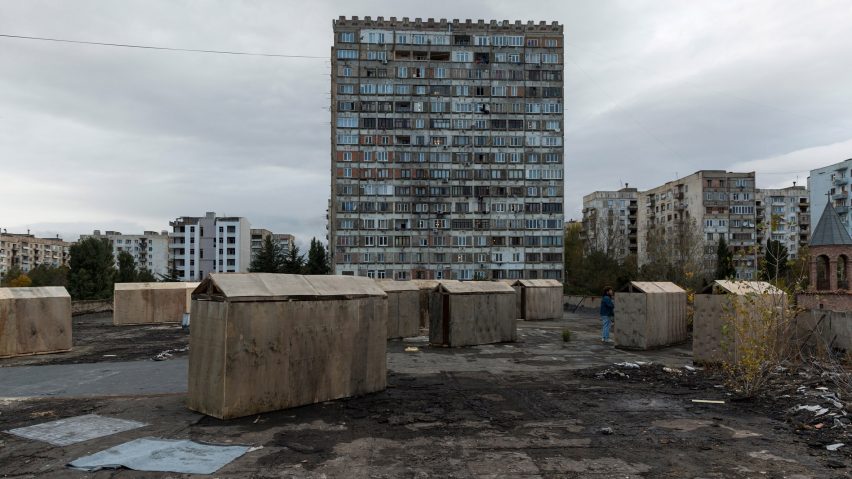
"Hopeful moment" is emerging from Tbilisi's architectural chaos
Tbilisi is at a crossroads, with its architectural heritage being eroded and uncontrolled development underway. But there are reasons to be optimistic, according to architects at the Georgian capital's inaugural architecture biennial.
The Tbilisi Architecture Biennial 2018 took place from 26 October to 3 November. It was set up to give architects a platform to discuss the current state and future of the city, which is the capital of Georgia – a former Soviet country on the border between eastern Europe and western Asia.
The city is grappling with the scars and glitches of its fraught and complex history, and politicians and developers have before now been unwilling to engage with architecture, according to the event's directors.
"We lack good quality architecture," said TAB artistic director Tinatin Gurgenidze, who co-directed the biennial with Natia Kalandarishvili, Otar Nemsadze and Gigi Shukakidze.
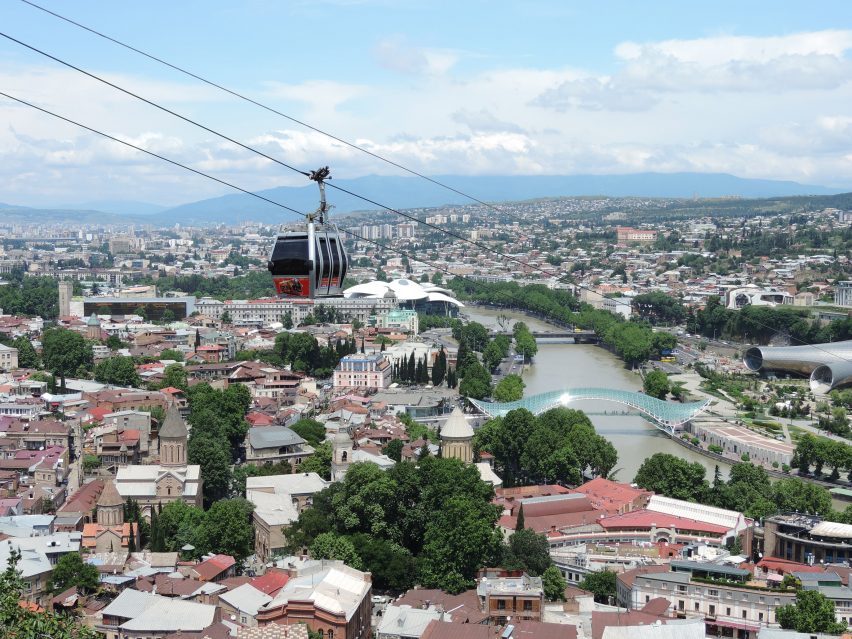
"There are all these high-rises from developers and investors making money out of every little spot available – or not available and making it available," she added. "There's super poor quality of architecture in Tbilisi."
New buildings "changed the city completely"
Tbilisi today has a population of approximately 1.5 million people.
The city centre is a jumble of glass skyscrapers and concrete towers poking up between the abandoned or repurposed post-war buildings and monuments. There are a few Soviet-era public-building gems from the 1970s and 80s, such as the expressionist Palace of Rituals and the neo-constructivist Ministry of Highways, but they are now under private ownership.
Meanwhile the city's picturesque old town is showing visible signs of decay, and its Soviet-era mass housing settlements are overpopulated.
The face of Tbilisi changed most dramatically under the presidency of Mikheil Saakashvili, who led Georgia from 2004 to 2013. He brought in a succession of overseas architects to create prestige buildings all over the country.
Among them were Italian architects Massimiliano and Doriana Fuksas. They designed the Tbilisi Public Service Hall, with its cluster of white fibreglass canopies that bloom above the city like a crop of giant toadstools, and the curving Rhike Park Music Theatre, which is complete but never opened.
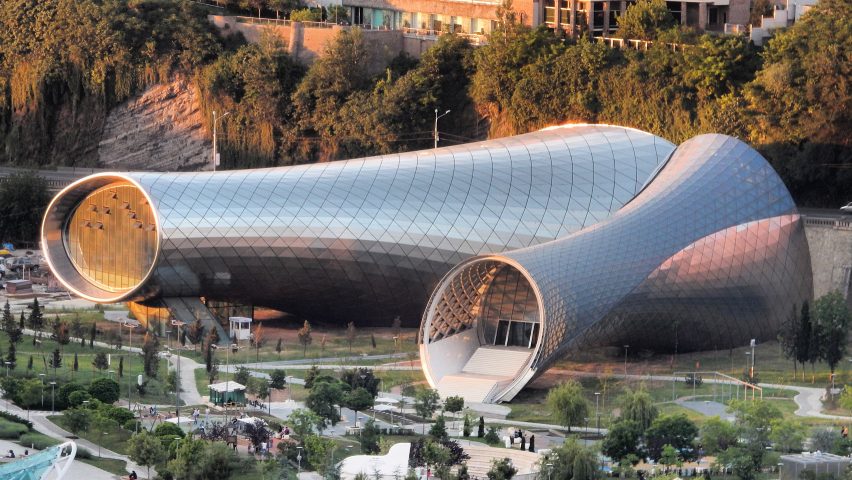
However there was a lack of coherent urban planning, meaning Tbilisi became increasingly choked by traffic.
"It was good that there were new things popping up, but the quality of the construction was horrible," said Gurgenidze. "They changed the city completely, and now the next government does the same – buildings in the centre that are completely out of context.
Architectural anarchy could have "beneficial effects"
OMA partner Reinier de Graaf believes Tbilisi's political chaos and the resulting architectural incoherence could provide a window of opportunity.
"When things are a mess then lots is possible," he told the audience in a keynote speech at the biennial's symposium.
"[Tbilisi] is at the stage where a certain amount of anarchy still has beneficial effects, which I hope will continue to last. It's seemingly a hopeful moment in the city," he told Dezeen in an interview following the keynote.
"An absence of a certain system and the absence of a certain order simply enlarges the scope of possibility, for better or for worse," he added. "As an architect you are condemned to optimism."
Biennial offers a platform for discussion
The biennial comes in the midst of a construction boom that is throwing up tower blocks at an alarming rate for a city that sits within a highly active seismic zone.
Georgia's politicians have left people generally disillusioned with their ability to confront the issues facing the city but, as housing conditions and air quality worsens, social pressure is mounting.
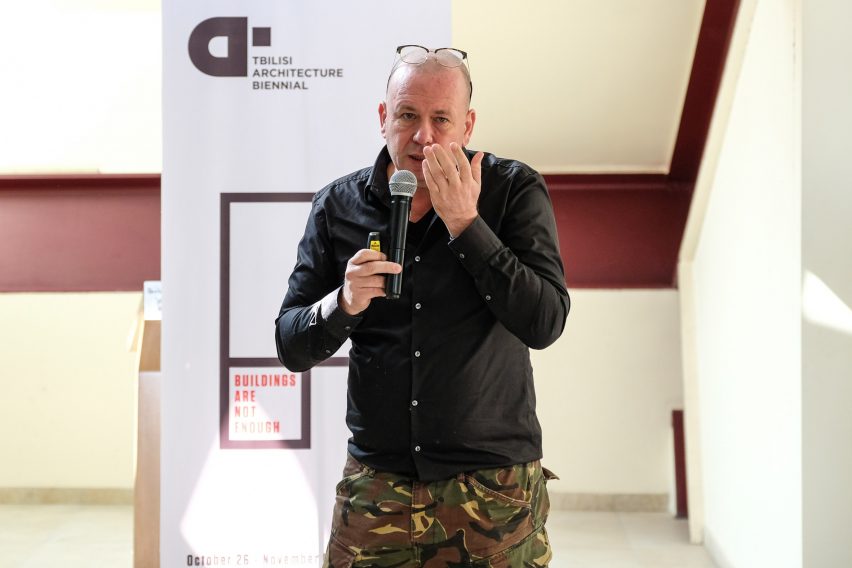
One particular project has galvanised public opposition. Panorama, a luxury complex featuring a seven-star hotel and a golf course, which will be carved into the side of a mountain.
The development is being funded through offshore accounts by former prime minister and billionaire Bidzina Ivanishvili, who has already built his own glass palace further down the hillside. A cable car connecting it to the valley floor is regarded by many residents as particularly destructive.
"Georgia is a poor country. There are so many people living in small apartments, then you build something luxurious," said Gurgenidze. "It's doesn't fit together. It's just making profit for investors."
Gurgenidze hopes the biennale will at last create an opportunity for discussion on these kinds of issues, which before now didn't exist.
"Our aim is to create a platform for different professionals, policymakers and communities to come together and discuss architectural topics," she explained.
"There are some circles that are working on urban issues in architecture, but there is no general discussion. The community is so small that the competition is so high that if you don't agree you don't talk to each other. That won't solve the problem. We want people to get engaged."
Participants embraced Tblisi's spirit of anarchy
The eight-day biennial, co-funded by the EU's Creative Europe Programme, was based in the suburb of Gldani. It encompassed a two-day symposium, outdoor and indoor exhibitions, film screenings, and reclaimed spaces around the city.
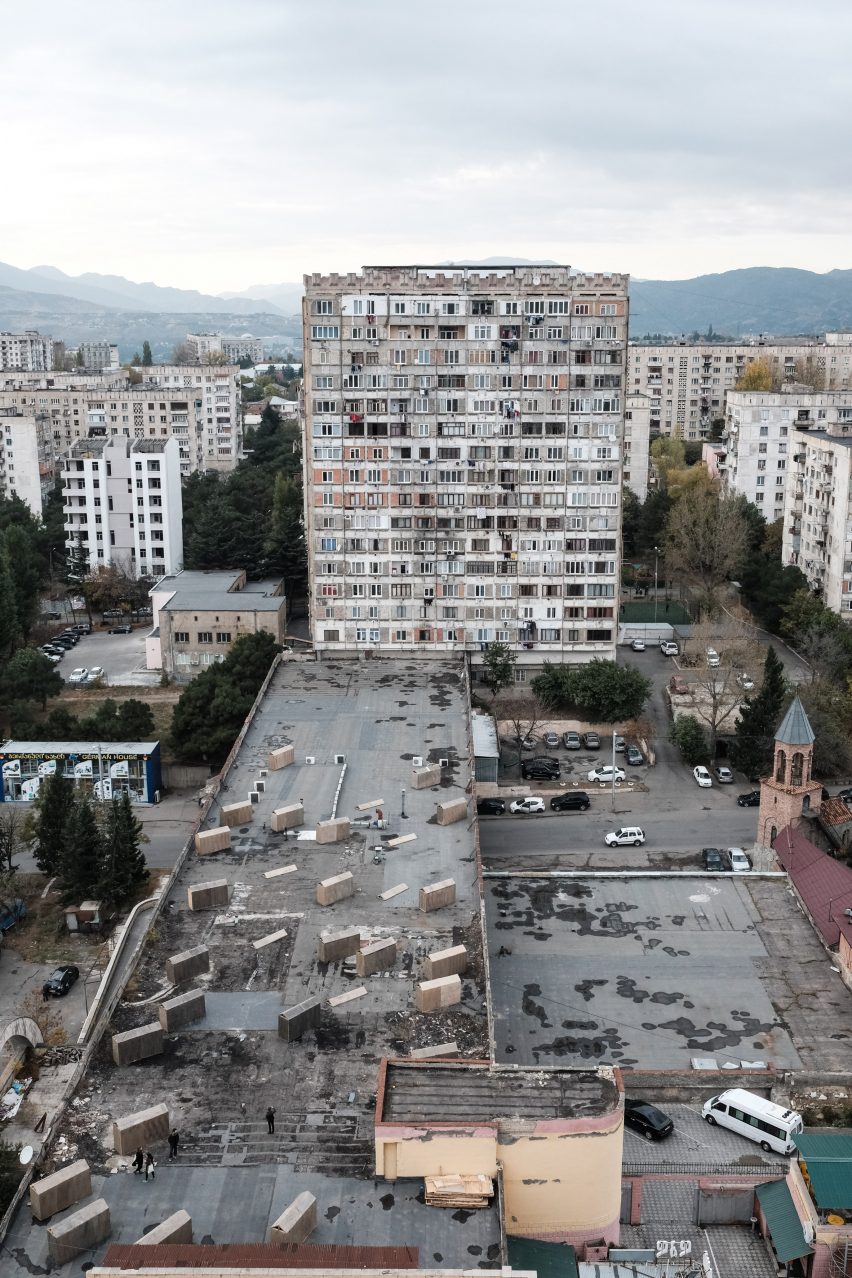
A Soviet-era micro-district, Gldani embodied the theme chosen by the directors: Buildings Are Not Enough.
Severe overcrowding and a lack of repairs – for instance, many central heating systems were illegally stripped and sold off decades ago – have forced residents of the concrete mass housing to be recklessly creative in DIY additions. Balconies have been bricked up to add extra rooms and, in some instances, entire blocks have bolted on jutting extensions from cobbled-together building materials.
Exhibitors at the biennial's outdoor exhibition embraced this spirit of anarchy with their pavilions and installations, building gonzo structures to deliberately highlight the city authorities' haphazard approach to planning.
Stefano Tornieri, Marco Ballarin and Massimo Triches – co-founders of Italian architecture and landscape office Babau Bereau – transposed the Mausoleo di Santa Costanza, a fourth-century basilica in Rome, into a courtyard in Gldani.
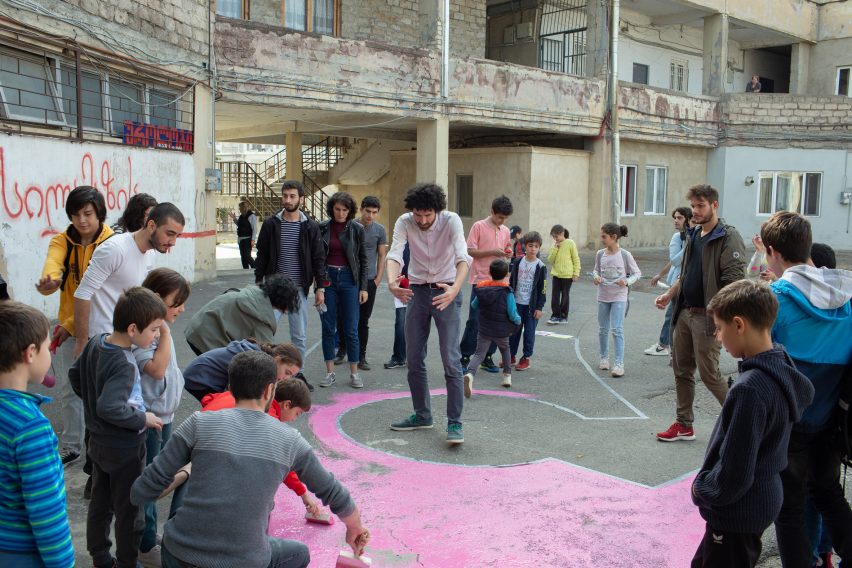
They used pink paint to map the floor plan directly onto the ground and erected a temporary wooden structure to evoke the dome. Within hours, children from the block had commandeered the floor mural as a makeshift playground and football pitch.
"We can definitely learn from the informalities we have studied for future change," Gurgenidze explained. "This a demonstration of the relationship between dwellers and their built environment, and how the residents are influenced by the architecture and vice versa."
Hopes to preserve Tbilisi's architectural heritage
The feeling among most TAB participants was that the majority of new buildings going up in Tbilisi are inappropriate, while existing architectural opportunities are being overlooked or actively destroyed.
"Hopefully they will stop still building contemporary things and big skyscrapers," said architect Alexander Brodsky, one of Russia's feted paper architects of the 1970s.
"I hope they will preserve the city as it is here," he added. "I hope that they save the old buildings of Tbilisi. I do not see it as a city full of contemporary buildings. But I do not know what is going to happen, because of the developers."
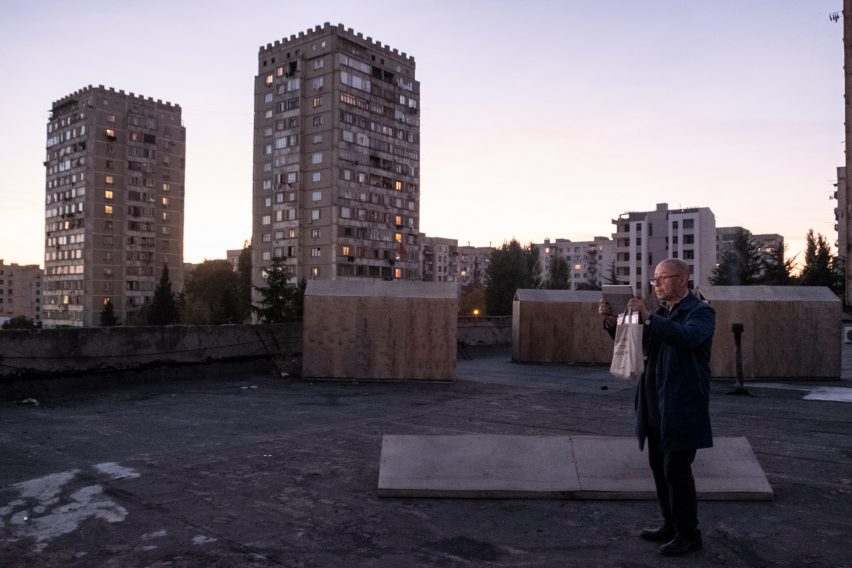
For his contribution to the biennial, Brodsky and a team of acolytes built a herd of spooky wooden shacks advancing across a Soviet-era bridge in Gldani, coating the sides in diluted black paint to match the landscape of weathered concrete towers.
Architecture can "renew the social spirit"
Some participants took a more radical approach to the theme Buildings Are Not Enough, taking it as a call to action.
American architecture graduate Thomas Ibrahim led a takeover of Industrial Technicum Theatre, a Soviet-era building that juts out from the hillside, crowned by a half-destroyed sculpture of Icarus by Zurab Tsereteli.
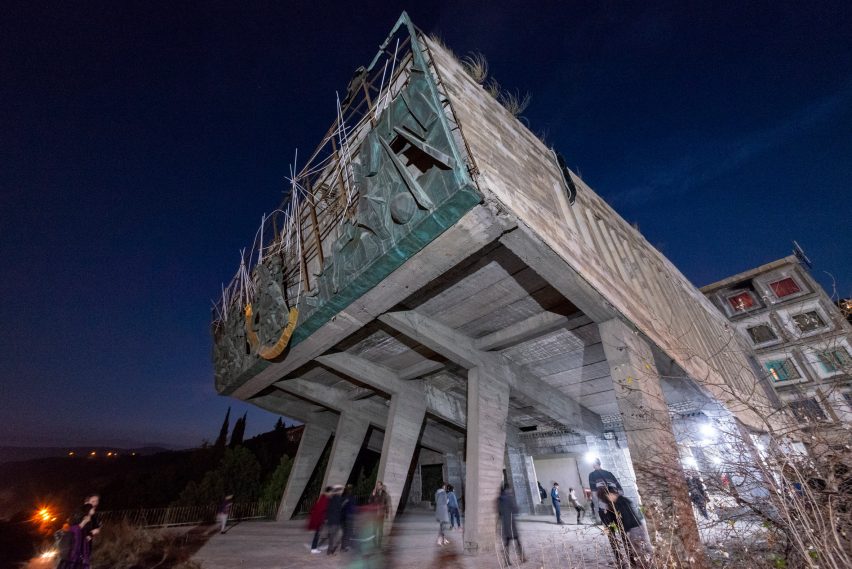
Georgians displaced as a result of the country's civil wars inhabit the building, jerry-rigging plumbing and burning wood for heat create homes for their families. The city authorities do little to improve their conditions.
"Five people live in a room that's 16 square metres with nothing for privacy other than a curtain, and they share a bathroom with another 40 people," Ibrahim told Dezeen.
Together with his collaborators, Gio Sumbadze, Givi Machavariani and Claudio Vekstein, Ibrahim arranged with the municipality to have a level of the building cleared of rubble before building an access stairway, guerrilla-style, to allow the residents to take over the space.
Since then, local architecture students have been working with the refugees to build a swing, fire pits and benches to furnish the space as a community meeting place.
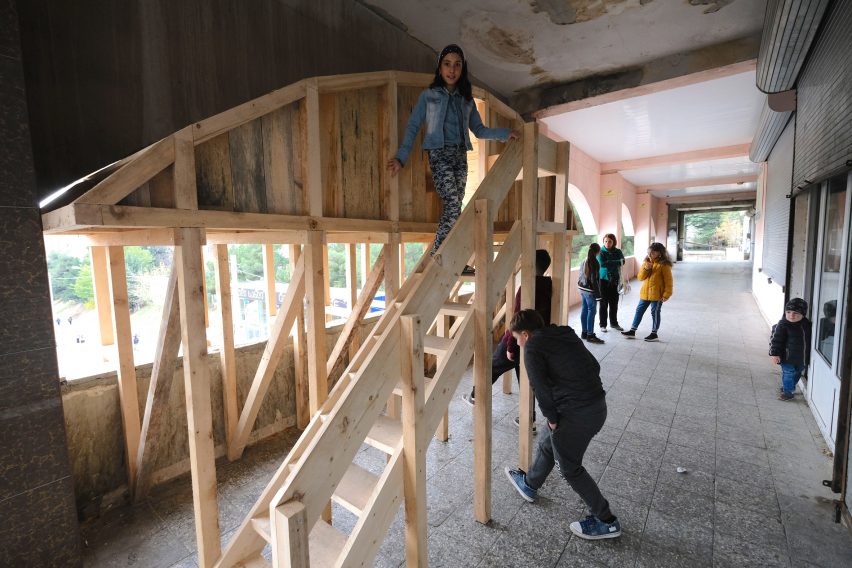
Ibrahim hopes his project, called Inhabit! post-Soviet Tbilisi, will help save the building from developers and re-appropriated as a public facility, not just for the residents but for Tbilisi as a whole.
"One of the biggest failings of the country is the loss of all the public buildings in the city," he explained.
"There are several efforts that we are trying to consolidate into one big movement that is to create something that adds to value to the city, to the lives of people, to renew the social spirit between the people who are living in this building and the people who are living in the city."